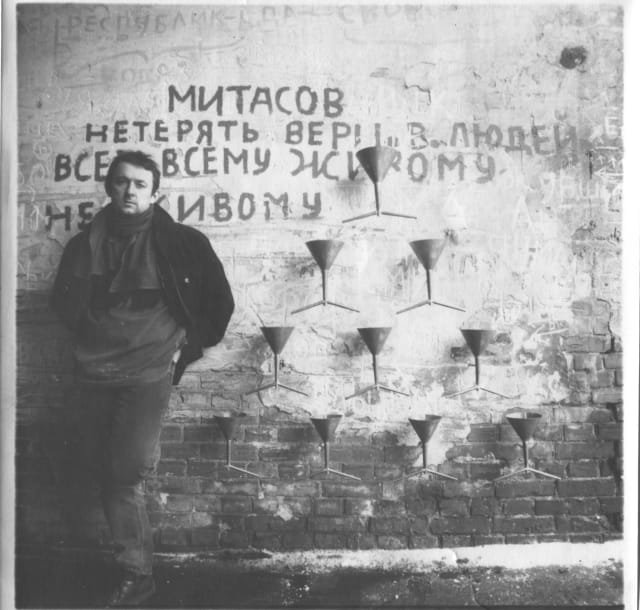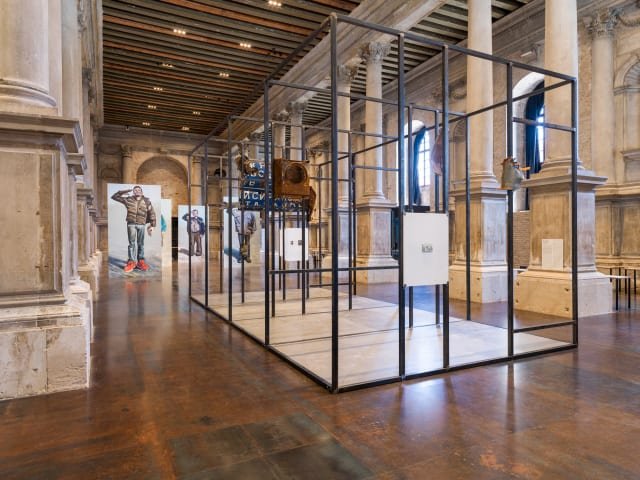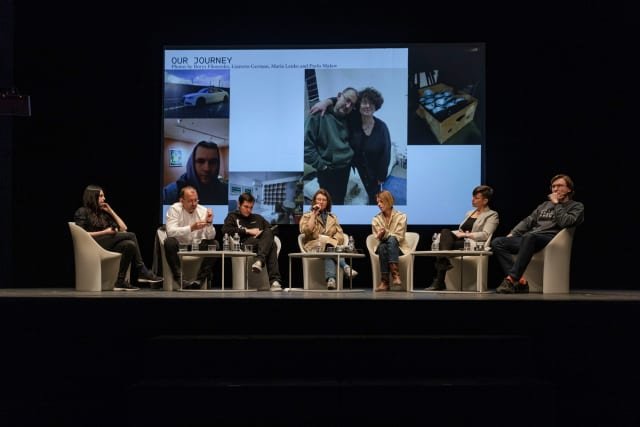Pavlo Makov’s sculpture for the Venice Biennale sends a striking message of determination and fortitude as Russia continues to threaten Ukraine.
Art curator Maria Lanko left her home in Kyiv on the evening of February 24, just hours after Russia launched a full-fledged invasion on Ukraine. She packed only a few personal items inside her trunk, along with 78 bronze funnels belonging to Pavlo Makov, one of the country’s most prominent living artists, as she was unsure of her exact strategy and faced a potentially dangerous journey ahead. Her job was to get them out of the nation and out of harm’s way.
Makov, 63, and his team of curators, which included Lanko, won a proposal to represent Ukraine at the Venice Biennale, a major international event regarded as the “Olympics” of the art world, last year. The funnels were essential components of their proposed entrance, a water fountain sculpture known as the “Fountain of Exhaustion.”

Makov has lived and worked in Kharkiv, a city in northeast Ukraine, for almost three decades. It was the mid-1990s, and the post-Soviet country was still transitioning after its citizens opted for freedom in a referendum in 1991. The fountain was meant to be a metaphor for Makov’s country’s social and political fatigue as it battled with the civic and economic issues that come with reconstructing an independent state. Constant water shortages in the city also prompted him to consider the project from an ecological standpoint, as he pondered the concept of finite resources.
“Fountain of Exhaustion” has taken several shapes throughout the years, ranging from sketches and prints to technical designs and physical installations. The version for Venice was to be the first completely functional fountain, with 78 funnels installed in such a way that the initial stream of water divides again and again as it makes its way down the triangle structure, diminishing its flow until it reaches the bottom.

Makov and his colleagues tested the freshly constructed fountain a week before Russia invaded Ukraine to ensure that the water flowed properly. The installation was successful thanks to the design and technical help of Forma (A), a Kyiv-based architectural firm. The group was overjoyed.
Everything changed shortly after that. While the fear of conflict had been mounting for some time, giving the team time to contemplate contingency preparations, the abrupt attack on Ukraine made it appear impossible to present the work in Venice, which was less than two months away.
Traveling from Ukraine to Italy is a long and winding road.
In the early days of the battle, the team’s primary concern was personal safety, as they hurried to put together escape and shelter preparations with family and friends. Lizaveta German, one of Lanko’s co-curators, was significantly pregnant and residing in a Kyiv flat when the conflict broke out. When the first missiles were launched, German was just days away from her due date and wanted to stay in the city to be close to her maternity hospital. As the situation worsened, she and her husband took the tough decision to relocate to Lviv, Ukraine’s cultural centre, which was less vulnerable. Borys Filonenko, the project’s third co-curator, joined her there.
Lanko, on the other hand, was still driving. She crossed the border into Romania after six days on the journey with 78 funnels jammed into three boxes. She took a break in Budapest, Hungary, after becoming fatigued from the near-constant travel, before arriving in Vienna, Austria’s capital.

Makov, who was working on his own evacuation plan, was waiting for her there. When the war broke out in Kharkiv, he gathered his family in his apartment for the first two days. However, the city was being bombarded so heavily that they were forced to take refuge in a bomb shelter for about a week, and as the situation worsened, the artist decided to evacuate, driving out of the city with his 92-year-old mother, his wife, and two other ladies.
On March 16, German gave birth to a newborn boy in Lviv. She spoke to CNN ten days later in a hotel in the city about the significance of art in times of extreme hardship. “I believe art has the symbolic capacity to celebrate people’s lives and to convey that we are still here — to show that Ukraine isn’t only a war victim,” she said.
Lanko had arrived in Italy by that time. In Milan, she found a production business that agreed to re-create the sections of the installation she had abandoned in Ukraine.

Suddenly, it appeared that they would make it to Venice despite all obstacles. The squad members also began to believe that they should serve as ambassadors for their country. Makov and his colleagues were mounting a different form of defence against the invasion as their fellow Ukrainians fought Russia on the front lines, served in hospitals, and volunteered.
“For a long time, Russian art has eclipsed Ukrainian art,” German added, cradling her infant close to her chest. “The cultural field must also be a battleground, and we must fight.”
Lanko, Filonenko, Makov, and German (with her infant) were reunited in Venice a few weeks later to finish final preparations.
‘Blood money’ attention
Makov claimed he does not consider himself an artist, but rather a citizen of Ukraine whose responsibility it is to represent his country, in an interview two days before the project’s press launch.
“I recognised that having Ukraine represented (at the Biennale) was critical.”
The sculpture, which had previously been a wide meditation on how the world had exhausted itself, had taken on a new meaning as a result of an inflow of interest from the media and the art world. It had inadvertently become a work of “war art,” and the team has struggled with being in the spotlight. “It’s partly paid for with blood,” Lanko explained.
“We welcome all of the attention because we recognise that we are the’speakers’ at this time — ambassadors of our country and culture,” she stated, adding that she hopes the conversation surrounding the pavilion will expand to include Ukrainian art in general.
Makov was not the only Ukrainian artist whose work was on display during the first week of the Venice Biennale. In the festival’s Giardini area, a solitary work by the late Maria Prymachenko hangs subtly near the entrance of the main pavilion — a quiet tribute to one of the country’s most illustrious 20th century artists, whose name made headlines last month when a museum containing more than a dozen of her works was attacked by Russian forces. It’s possible that not all of the artwork survived the fire.
President Obama’s message
A few miles away, in a building approximately 30 minutes walk from the main Biennale site, is a show of work by Ukrainian artists over the previous few weeks. It’s a powerful reminder of the war’s impact on many creative people, as well as another illustration of Ukrainian artists’ determination and endurance.
Lesia Khomenko, for example, is exhibiting a series of large-scale portraits titled “Max in the army,” which she named after one of her subjects: her husband, Max, who was a member of the armed resistance. Large bits of shrapnel and rubble, taken from Donbas in 2015 during the last Russian invasion on Ukraine, and later from Kyiv in 2022, hang from a frame in Nikkita Kadan’s “Difficulties of Profanation II.”
President Volodymyr Zelensky of Ukraine, speaking via video at the exhibition’s opening ceremony, said, “Art can tell the world things that cannot be expressed otherwise,” and urged the audience to support his country through art, words, and “influence.”
Björn Geldhof, the exhibition’s curator, put the show together in just four weeks. During a tour of the facility, he said: “It is difficult to create during a war. But one of the things we wanted to do was illustrate the remarkable tenacity of current Ukrainian artists.”
On the opening day of the Ukraine pavilion, this character strength was on full display. A moment of silence for the people of Ukraine was observed at a news conference to commemorate the unveiling. While the media and tourists continued to claim that the installation’s creators are heroes, Makov and his curators brushed aside cliches by reminding people that the true heroes are those on the battlefield, in hospitals, and in besieged places.
The team’s judgement of art’s power to resolve conflict was also evaluated. “I often believe that art is more of a diagnosis than a treatment,” Makov explained. “I’m not convinced it can save the planet, to be honest. However, it has the potential to aid in the world’s salvation.”
Lanko had previously expressed similar sentiments: “Art isn’t going to stop the war right now,” she added, “but it might stop the next one.”
The “Fountain of Exhaustion” is not a symbol of optimism for German, but she feels that the fact that it made it to Venice at all will “offer hope” and demonstrate that Ukraine is capable of overcoming adversity.
“Even while the fight continues, we have the ability to build our future.”


